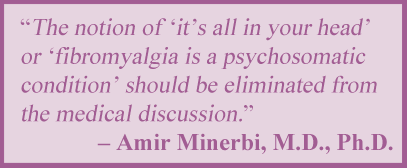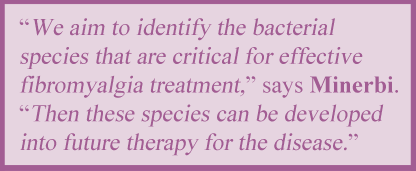Treatment & Research News
Targeting the Gut
for treating fibromyalgia
Home | Treatment & Research News

Your gut bacteria or microbiota form a living community that communicates with your brain. In fact, your microbiota exert significant control over your overall health. Five years ago, Amir Minerbi, M.D., Ph.D., of Israel published a groundbreaking study showing microbiota abnormalities in fibromyalgia.1 Today, treating the gut microbiota in fibromyalgia represents a novel approach.
If studying your gut microbes seems off topic for fibromyalgia, see our article on Gut Influences. Ordinarily, the intestinal bacteria and central nervous system have a “healthy” relationship. But in people with fibromyalgia, the bugs living in the gut are different from healthy, pain-free people. New research by Minerbi’s team reveals that the altered microbiota are linked to fibromyalgia symptoms.2
Transferring Fibro to Mice
Transplanting the microbiota from fibromyalgia patients into the digestive tract of mice causes the animals to become pain sensitive. The process is called fecal microbiota transplantation (FMT). Alterations in the mouse’s microbiota is linked to increased pain sensitivity during the first two weeks. Not only does the microbiota of the mice mimic that of the fibromyalgia patients, but the mice also develop fatigue. FMT from healthy people does not impact the mouse’s symptoms or microbiota.
Pain Precedes Depression
All too often, fibromyalgia is wrongly dismissed as depression or anxiety. The medical community calls these “affective traits.” Understandably, affective traits negatively impact a person’s health and contribute to reduced pain thresholds. However, it is frustrating for patients to be told that their fibromyalgia is caused by their state of mind.

To set the record straight, Minerbi selected fibromyalgia patients who did not have symptoms of depression or anxiety. “It was important to show that pain hypersensitivity is not mediated by affective traits,” says Minerbi. “The fact that pain is detectable in the mice days following FMT but depressive signs arise months later is a hint that pain precedes depression.” As a result, treating gut microbiota in fibromyalgia may reduce pain and prevent the mood disorders.
“The notion of ‘it’s all in your head’ or ‘fibromyalgia is a psychosomatic condition’ should be eliminated from the medical discussion,” says Minerbi. “Patients, families and clinicians need to know this.”
Altered Metabolism
Gut microbes can influence the production of pain-enhancing amino acids like glutamate and alter fat metabolism. The bacteria can also increase the production of bile acids that cause pain, rather than relieve it. These unwanted effects are well-documented in people with fibromyalgia. And it turns out, the mice receiving FMT develop the same metabolic abnormalities as the patients. Quite possibly, treating the gut microbiota in fibromyalgia patients can decrease glutamate and lead to reduced pain.
The mice didn’t just have increased glutamate in their blood, the concentration of this pain transmitter was also elevated in the central nervous system. This goes to show that transferring microbiota into the gut significantly impacts brain function.
Immune Changes
Your intestines are lined with immune cells. In addition, lymph and a variety of immune cells surround your digestive tract. If the microbiota in the gut is altered in an unhealthy way, the immune system might become actively defensive. This angle was explored by Minerbi’s colleague, Arkady Khoutorsky, DVM, Ph.D.*
Looking at the numbers of immune cells in the blood of mice, Khoutorsky found the memory B cells were nearly depleted. Memory B cells help your immune system remember prior exposures of potentially threatening agents. If the agent enters your body again, your memory B cells pump out antibodies to neutralize the threat. Khoutorsky did another test that showed increased activation of the immune system.
People with fibromyalgia have activated immune cells in their brain called microglia. Minerbi found these same cells to be on guard in the brains of mice exposed to fibromyalgia FMT. To measure the microglia’s role, he blocked their activation with a medication prior to the FMT. The ability of fibromyalgia microbiota to produce pain sensitivity was greatly reduced. “These results indicate that the development of pain after fibromyalgia FMT is partially mediated by the microglia.”
The Neurons
Most fibromyalgia patients will say their skin burns, their muscles ache, and their brain function is dulled (e.g., fibrofog). It’s hard to believe that the far-reaching effects of fibromyalgia are solely due to malfunctions in the brain and spinal cord. Conversely, if the muscles were the source of disease, how would one explain the common symptoms of fibrofog and sleep disorder?
Prior studies show a misbehaving immune system targets the dorsal root ganglia (DRG) to amplify pain transmissions. But other neurons are also affected. “The DRG is an attractive target,” says Minerbi. “But in our study, there are changes in all levels of the pain-signaling pathways. The peripheral small nerve fibers, the DRG, the spinal cord, and the cortical structures in the brain are all involved.” At least, this is what Minerbi found in the mice when he looked at the effects of FMT from fibromyalgia patients. So, the neurons at all levels of the nervous system may be contributing to your symptoms.
But how can you relate this finding to the bugs growing in your intestines? Disruption of your gut microbiota leads to activation of your immune system. After all, the immune cells lining your intestinal tract are programmed to protect you from foodborne pathogens. If the bacteria in your gut changes composition, they can also set off alarms targeting all levels of your nervous system. So, treating the gut microbiota in fibromyalgia patients can mute the immune system and reduce pain signals transmitted by the neurons.
FMT in Fibro Patients
A small trial of FMT from healthy subjects to fibromyalgia patients led to a 30 percent reduction in pain. But just doing the FMT alone did not work. Patients had to be given antibiotics before the ten-week trial (five transfers every two weeks).
“The microbiota in the gut is a stable environment,” says Minerbi, “and it’s resilient to transient perturbations. The amount of bacteria we give in FMT is many orders of magnitude smaller than that of the established microbiota in the gut.” So, antibiotics are given to clear out the existing bacteria and allow the transplanted bacteria to take hold.
Based on the success of this small trial, a large placebo-controlled study is underway. Minerbi’s team will be looking at which bacteria improve the most, in addition to alterations in the metabolic and immune system variables.

“We hope this will help explain why certain fibromyalgia patients respond better than others,” says Minerbi. “We also want to identify the biological mechanisms responsible for symptom improvements.”
Designer Treatments
Even if FMT turns you off, it provides much-needed answers from a research perspective. Perhaps the greatest downside of FMT is that it cannot be commercialized. Minerbi points out that some companies already have FDA-approval for microbiota-based therapeutics. Basically, these companies aim to develop specially formulated probiotics to treat illnesses like fibromyalgia.
“We aim to identify the bacterial species that are critical for effective fibromyalgia treatment out of the hundreds that are given during FMT,” says Minerbi. “Then these species can be developed into future therapy for the disease. Since fibromyalgia is a diverse condition, there may need to be more than one formulation.” Indeed, treating the gut microbiota in fibromyalgia patients may be tailored based on one’s microbial composition.
In the Meantime …
If you are tempted to purchase multiple probiotics to tame your fibromyalgia symptoms, press the pause button. Hundreds of bacterial species live in the gut but only a few are contributing to your symptoms. On the other hand, Minerbi says that the probiotics on the market do not contain any species suspected to be involved in the disease. You are also up against the fact that your existing microbiota community is resilient to change.
It’s frustrating to know that a disruption of your microbiota is likely linked to your symptoms, but you can’t just correct it with probiotics. Until designer treatments become available, Minerbi recommends a low-sugar and gluten-free diet, exercise regularly, and get plenty of sleep. See Diet & Nutrition for assistance. These measures are known to help maintain a healthy community of gut bacteria.
Research takes time, and this is frustrating to hear. But keep in mind that seven years ago the microbiota was not known to be involved in fibromyalgia. “The results are promising, so there is hope on the horizon,” says Minerbi.
AFSA funded six projects in the past two years, and one award went to Dr. Minerbi to expand his amazing research. Help us fund more studies in 2026.
Stay Current on Treatments & Research News. Sign up for a Free Membership today!
Symptoms | Medications | Alternative Therapies | Muscle Pain Relief | Fibro Friendly Exercises
* Minerbi’s team of collaborators include Yoram Shir, M.D., Arkady Khoutorsky, DVM, Ph.D., and Emmanuel Gonzales, Ph.D., of McGill University in Canada and Nicholas Bremerton, Ph.D., of University College in Dublin.
- Minerbi A, et al. PAIN 160:2589-2602, 2019. Free Abstract
- Cai W, Shir Y, Minerbi A, Khoutorsky A, et al. BioRxiv Oct 28, 2023. Free Report
